| | |
Warning: This infobox has missing parameters: sector, system and unrecognized parameters: defacto
- "The Galactic Republic was the Republic of legend, greater than distance or time."
- ―Janyor
The Galactic Republic, also known as the Grand Republic or simply as the Republic, was a democratic union comprising thousands of star systems spread across the galaxy. Old Republic was a term affixed to the pre-modern Republic that existed until 1032 BBY, and the modern Republic that was supplanted by the Galactic Empire in 19 BBY. In addition, the term High Republic denoted the era in which the Republic reached the zenith of its power from 300 BBY to 82 BBY. The Republic was founded many millennia before the Battle of Yavin, approximately 25,000 BBY, around the same time as the Jedi Order. The Galactic Senate governed the Republic under the Galactic Constitution, and comprised thousands of senators representing the Republic's member worlds. The Supreme Chancellor was the title of the Republic head of state, elected from ranks of the Senate to lead the government on Coruscant. An ecumenopolis or city-covered planet, referred to as Galactic City, Coruscant was the capital of the Republic and therefore the seat of the Senate.
The Republic governed the galaxy from the Core Worlds to the Outer Rim Territories, uniting various sentient species, human and alien alike, under one banner. As its power grew, the Republic fought many wars against various opponents such as Mandalorians, the Zygerrian Slave Empire, and several Sith Empires. The Jedi Order, a religious group of Force-sensitives dedicated to the light side of the Force, was sworn to the service of the Senate, and as such the Jedi Knights were hailed as the guardians of peace and justice within the Republic. After centuries of conflict, culminating in the fall of the Old Republic, the last war between the ancient Jedi and Sith concluded with the restoration and rise of the modern Galactic Republic, ushering in the Republic Era which was an age of peace that lasted for a thousand years. The Republic's history was officially reset, and the ages before this event were merged into a collective whole known as the Old Republic-era.
The Republic entered a period of decline after centuries of expansion and prosperity. Aided by the resurgent Sith Lords, the Separatist Crisis divided the galaxy between the Republic Loyalists and the Confederacy of Independent Systems. The Grand Army of the Republic was organized under the leadership of Jedi Generals who led the Republic Military against the Separatist Droid Army during the Clone Wars. However, the conlfict had been orchestrated to allow Supreme Chancellor Sheev Palpatine—the alter ego of Darth Sidious, Dark Lord of the Sith—to control the Republic in a dictatorial manner. With the war's end and the extermination of the Jedi through Order 66, Sidious transformed the Republic into the Galactic Empire by declaring himself Galactic Emperor. The Imperial Senate stood as the last remnant of the Old Republic until it was disbanded by the Emperor at the height of the Imperial Era. In the aftermath of the Galactic Civil War, the Alliance to Restore the Republic was fully reorganized into the New Republic, restoring the democratic system of its predecessor after a generation of Imperial rule.
History
Birth of freedom
- "For over a thousand generations the Jedi Knights were the guardians of peace and justice in the Old Republic. Before the dark times. Before the Empire."
- ―Obi-Wan Kenobi

The pre-modern Galactic Republic was referred to as the "Old Republic."
The original Galactic Republic was formed in approximately 25,000 BBY[11] and rose to power by expanding across the galaxy,[14] with several of its founding members being the planets Alderaan[17] and Chandrila.[18] Around 20,000 years prior to the Imperial Era, the Thisspiasian Blood Monarchy joined the Galactic Republic in its early founding.[19] Multiple versions of the Republic existed throughout its extensive history; historians referred to this pre-modern period as the "Old Republic,"[14] although the government's official name was the Galactic Republic.[20] The Old Republic's capital was located on the urban world of Coruscant, and would remain there for thousands of years.[21]
At least six thousand years before the start of the Galactic Civil War, a rogue faction of Jedi broke away from the Jedi Order, believing that practicing the dark side of the Force would benefit in the furthering of Jedi power. This schism divided the Order on ideological grounds, igniting an event known as the Hundred-Year Darkness, which, in turn, resulted in the formation of the Sith.[22] At one point, they managed to construct a dark shrine on Coruscant. The rogue faction was ultimately defeated and they were exiled from the Old Republic into uncharted space.[5]
At some point, the Jedi Temple was constructed over the Sith shrine in order to contain its dark energy.[5] Once it had established itself on Coruscant, the Jedi Order came to closely associate itself with the Old Republic, serving as guardians of the peace and justice for over a thousand generations.[23] Little did the Jedi know, the Sith had regrouped on the planet Moraband.[22]
Thousands of years before the Imperial Era, the Corellian royalty sponsored exploration and colonization efforts that helped expand the frontiers of the Old Republic.[24]
A clash of destinies in the galaxy
- "The history of the Ascendancy is in these rooms, some of the pieces dating back to Chiss participation in the wars between the Galactic Republic and the Sith Empire."
- ―Mitth'raw'nuruodo, to Ar'alani
As the Old Republic spread its influence across the stars, it came into contact with various other powers, one of them being the Zygerrian Slave Empire. Due to the fact that, at some point in its past, the Old Republic declared slavery illegal and expected other civilizations of the galaxy to comply, it took an aggressive stance against the Zygerrians. The Zygerrian Empire, which was built upon slavery, refused to comply, forcing both the Old Republic and the Jedi to intervene. After joining together, the Old Republic and Jedi Order sent their armies against the empire after the Zygerrians refused. The Old Republic ultimately came out victorious, driving the practice of slave trading into the underworld, dismantling the empire, and confining what was left of its government to Zygerria, the civilization's homeworld.[25]
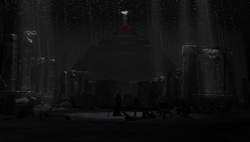
Destructive wars were fought between the Sith and the Jedi in the age of the Old Republic.
Eventually, the Sith would return in full strength, invading the Old Republic. From there, the dark Order would do battle with the Jedi and the Old Republic. This would lead to a series of conflicts between both groups that would go on for thousands of years until the Old Republic's ultimate collapse.[22] During one of the wars, the Jedi fought the Sith Empire on Malachor, which proved to be one of the most devastating battles in the history of the Order.[26]
At some point, the Old Republic came into contact with the Mandalorian people. The warrior civilization began a series of unprovoked military campaigns against the Old Republic. Later on, after all-out war erupted, the Jedi stepped in to defend the Republic.[27] In the meantime, Republic and Jedi forces continued to wage war against the expanding Sith Empire. During these wars, both sides would construct massive superweapons powered by large kyber crystals capable of mass destruction.[28][29]
The Galactic Republic also participated in the Sith Wars, a series of conflicts against the Sith Empire and involving the Chiss Ascendancy. The Ascendancy encountered a number of aliens before retreating to their borders.[20]
Fall of the Old Republic
- "This lightsaber was stolen from your Jedi Temple by my ancestors during the fall of the Old Republic."
- ―Pre Vizsla, to Obi-Wan Kenobi, regarding the Darksaber
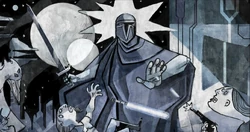
The Mandalorian Wars brought on the beginning of the Old Republic's downfall.
With the civilization of the Sith and the warrior culture of Mandalore, and with their beliefs of continual warfare without regard to the Jedi mandate of protecting the weak, the Jedi Order continued to mobilize its forces in an effort to stop enemy incursion into Old Republic space.[27][22]
The power of the Sith Empire increased during the fall of the Old Republic. The Sith soon achieved near-dominance across the galaxy.[2] Also during this time, an ancestor of Pre Vizsla of House Vizsla,[30] leader of the Mandalorian group Death Watch during the Clone Wars, managed to steal the Darksaber from the Jedi Temple.[27]
At some point the galaxy entered a state known as the Dark Age. During this time, the Jedi-Sith War broke out. Early on in this conflict, the Old Republic capital world of Coruscant was taken over by the Sith during the Battle of Coruscant. Later on in the war, the Sith were driven off the planet by the Jedi during the Liberation of Coruscant.[14]
The fires of hope
- "The Republic victory was so definitive, that it reinvented itself, resettling its capital on Coruscant after a devastating ouster. History reset its chrono on this date, and from that moment, the modern Galactic Republic was born."
- ―Janyor
The Old Republic managed to regain some of its strength after its forces had reclaimed the capital, capable of going on the offensive.[14] The Jedi were strong enough to finally end its ancient war against the Mandalorian clans. A battle between both groups on the planet Mandalore left the planet ravaged and lifeless.[31] It was during this time too when the Sith were finally defeated. The armies of the Old Republic were able to defeat the remaining Sith by taking advantage of the infighting within the Order, which proved to be the Sith's undoing.[32] The Sith abandoned their traditional homeworld of Moraband after it was scarred by many wars.[33] Very few Sith remained by that point, and they ultimately destroyed themselves. Only one Sith Lord survived; Darth Bane reinvented the Sith by creating the Rule of Two. Henceforth, their ranks were limited to a Sith Master and a Sith apprentice.[32]
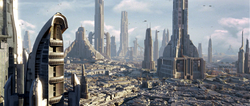
The Old Republic was reborn as the modern Galactic Republic after millennia of warfare.
As the Old Republic fell apart as a result of its continuous wars, the Jedi Order finally believed itself victorious from its conflict with the Sith, who they believed to have been destroyed completely. Finally, with peace restored to the galaxy, the shattered Old Republic reorganized itself into the modern Galactic Republic,[14] which would usher in over one-thousand years of stability in an epoch known as the Great Peace.[34] The story of Old Republic Regent Hylemane Lightbringer and his supposed immortality would be remembered in history texts along with Old Republic music such as the Sestina of Imperator Vex, which would continue to be sung even in the months following the Battle of Endor.[16]
Rise of democracy
- "There hasn't been a full-scale war since the formation of the Republic."
- ―Sio Bibble
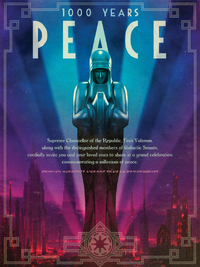
The Great Peace of the Republic lasted for almost a thousand years.
The Old Republic was restored[35] in the form of the modern Galactic Republic[14] in 1032 BBY.[13] After the Galactic Republic's reformation,[25] the Zygerrians would continue to hold a grudge against both the Republic and the Jedi Order for the destruction of their slave empire.[36][37][38]
The modern Republic was a democratic union that consisted of multiple star systems spread across the galaxy.[1] With the exception of small-scale conflicts that the Jedi dealt with, the Republic Era was an age of peace and stability that lasted for over a millennium.[14] This version of the Republic existed in a demilitarized state for most of its history;[8] as such, the government relied on the Jedi Knights, who upheld their mandate as the guardians of peace and justice.[39]
The Four Sages of Dwartii were notable in influencing some of its earliest laws.[40] As its governing body, the newly reorganized government established the Galactic Senate, the members of which were elected to represent their systems. Coruscant was the galactic seat of power under the Republic,[1] as it had been for thousands of years before the Republic's rebirth.[14]
The Republic's head of state, the Supreme Chancellor, was elected by and from the senators, in which the first in a long line of Chancellors[5] was Tarsus Valorum,[7] a scion of the House Valorum.[5][9] Protecting the new democracy was the elite Senate Guard, who could be seen patrolling the Senate District and came to be seen as symbols of strength and unity, especially considering the fact that the military had been disbanded.[5][41] In time, the Jedi Order, a noble order of protectors who could tap into the power of the Force, came to serve the Republic as guardians of peace and justice.[39] With the lack of a standing army, the Republic came to rely on its peacekeeping Judicial Forces, led by the Judicial Department as the de facto law enforcement branch of the government. The Judicial Forces, members of which were simply known as Judicials, trained at the Judicial Academy and came to serve in both ground and space forces, often led by Jedi Commanders to maintain peace throughout the galaxy.[5]
High Republic Era
Great Disaster
- "In the days of the High Republic, the galaxy was not as settled as it is now. Areas like the Outer Rim were dangerous, hard to navigate. So the people of that time built a huge space station at great effort and expense and placed it in the center of the dark zones. It sent out a signal that acted as a sort of beacon, helping travelers find their way. They gave that station an inspiring name, fitting its purpose."
- ―Grek
During the High Republic Era, Supreme Chancellor Lina Soh sought to unite the Outer Rim Territories with the Galactic Republic.
The High Republic Era saw the Galactic Republic reach the pinnacle of its power, its influence spreading to even the farthest and less settled regions of the galaxy by 232 BBY[42] during the chancellery of Lina Soh.[43] Starlight Beacon was constructed along with other way stations at considerable expense and effort in order to expand the Republic's domain to the unexplored "dark zones" of the Outer Rim Territories,[44] and the Jedi Order also became increasingly active in galactic affairs.[45] It was around this time when starships were abruptly knocked out of hyperspace in a galaxy-wide event known as the Great Disaster.[42]
Lacking a formal military, the Republic was protected by a small peacekeeping fleet known as the Republic Defense Coalition. The RDC deployed the Emissary-class Republic Cruiser Third Horizon to the Hetzal system as a result of the Great Disaster, responding to the Hetzalian government's distress signal. Jedi Master Avar Kriss was overseeing the rescue effort until she detected a large container of liquid tibanna threatening the system's R-class star. Kriss and the other Jedi left the Third Horizon to move the container with the Force, while the RDC focused on evacuating the remaining refugees.[43]
As the High Republic Era drew to a close around 82 BBY,[46] Jedi Padawan Sean remembered that the Nihil had launched an invasion of the Republic.[47]
Expansion and stagnation
- "With eyes toward expansion into the uncharted reaches of the Outer Rim, the traditions of the Core became passé. Opportunity beckoned from beyond the borders of the Mid Rim worlds."
- ―Janyor
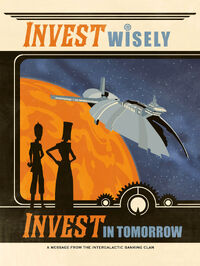
Commerce guilds generated massive profits by investing in the Republic's expansionist policy.
For centuries, the Galactic Republic expanded not through force but by quietly exerting a strong magnetic pull towards neighboring systems. The promise of trade with Core World markets held many systems in sway, inexorably luring non-member worlds into tighter cooperation with the state body. Despite this, the Republic remained slow to invite new systems into its fold, as the addition of new territories diminished the political power of existing senators. New member states invariably aligned themselves with local galactic power blocs, while most senators who gave the invitations represented systems in the Core. As a result, the Galactic Center represented the beating heart of the Republic that habitually drew wealth and power from the hinterlands, with most senators dismaying at the extension of services and protection to outlying worlds. Consequently, many useful star systems were left waiting—some for centuries—for the body politic to admit their world as a member of the Congress, even though it came at the cost of the body's overall power.[48]
As time went by the Republic stood firm, becoming increasingly powerful. As a result, the galaxy remained free of any full-scale war for centuries. However, many of the bureaucrats and senators that ran the government continued to work for their own profit rather than the common good. Greed, corruption and internal strife slowly began destroying the government from within.[1] The Core, revitalized from the destructive conflicts of the past and ravenous for new resources to exploit, embarked on an aggressive colonization policy, exploring, mapping, and settling untouched planets within the Outer Systems, striking deals with or simply overrunning the indigenous populations that stood in their path. Adventurous pioneers found themselves granted permission by Coruscant to settle new territories and establish trading colonies to feed the Core with the goods and raw materials for its continual self-enrichment. Many new systems, finding themselves lacking the funds to mine, process, and ship their products to market, were forced to secure high-interest loans from the InterGalactic Banking Clan, whereupon many, unable to repay their debts, found themselves as mere client worlds to the Muun bankers. As time progressed, the laborious task of astrogating by hyperwave beacons—which required numerous reversions to realspace—became simplified with the founding of new hyperlanes such as the Hydian Way. Many systems, eager to benefit from the opportunities offered by charting hyperlanes through their system, sought to influence the Republic Senate to put themselves on the galactic map.[5]
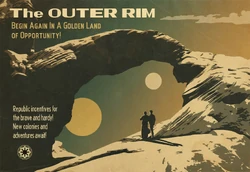
The Republic's doctrine of manifest destiny led to the colonization of the Outer Rim Territories.
Culturally, Coruscanti fashion, art, drama and literature saw receptive audiences across the galaxy. Seeking to impress visitors from the Core, many worlds sought to build lavish mansions that imitated the architectural style of the Inner Core. Despite this, many Coruscanti looked with disdain on what was in reality nothing more than a gaudy impersonation. To them, these lifeforms on the galaxy's fringes appeared barbaric, with most worlds still lacking weather control or struggling with geological disturbances and food shortages. Additionally, many outlying worlds, lacking the protection of a federal military found themselves continually harassed by numerous pirates and criminal organizations, further ingraining the long-held view that those from the galaxy's outlying settlements lacked cultural refinement and basic civility.[5]
A deep-rooted hatred and distrust grew over the centuries between the galaxy's outer fringes and the cosmopolitan Core, with those in the hinterlands gradually coming to believe themselves the victims of social and economic injustices. As a result of the perceived inability of the Judicial Forces in protecting outlying territories, who were often withheld in intervening after many far-flung worlds refused to provide the Core Worlds with profitable deals, the Outer Rim world of Eriadu—one of the most politically, culturally and economically developed worlds—formed the Outland Regions Security Force for the protection of the Seswenna sector. Comprising an amalgam of ships, it was funded primarily by off-world loans and supplied with laser and ion cannons acquired from arms merchants who had for centuries been ignoring a Republic ban on the sale of weaponry to member worlds. While the Outland Regions Security Force at first lacked success, it soon came to be renowned for its efficiency at dealing with raiders, especially after Wilhuff Tarkin was accepted into Outland's anti-piracy task force, in which he was known for outsmarting and outmaneuvering his opponents.[5]
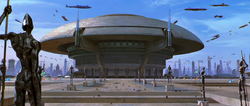
The Galactic Senate was mired in political corruption during the Republic's final years.
Yet despite Outland's best efforts, the Outer Rim Territories continued to fall victim to increasing corporate interests from the Core, with the monolithic Trade Federation expanding its reach a year before the Invasion of Naboo in both the Outer Rim and the Galactic Senate by utilizing loopholes in existing free-trade legislation. Shortly before the Invasion of Naboo, a trade summit was held on the Outer Rim planet of Eriadu in which Supreme Chancellor Finis Valorum was turned away by Wilhuff Tarkin, who was hoping to reduce the influence of the Chancellor who some already expected to lose the next election in order to support Senator Sheev Palpatine, who had earlier helped Tarkin gain entrance into the Judicial Academy and supported his ascension as Governor of Eriadu.[5]
Invasion of Naboo
- "It is clear to me now that the Republic no longer functions. I pray you will bring sanity and compassion back to the Senate."
- ―Padmé Amidala, to Sheev Palpatine
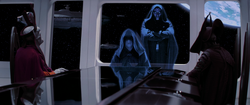
The Sith orchestrated the Invasion of Naboo by controlling the leaders of the Trade Federation.
Despite the best efforts of the well-meaning Chancellor Valorum,[49] the Trade Federation blockaded Naboo over disputes about plasma exports. A Judicial force carried Jedi Master Qui-Gon Jinn and Padawan Obi-Wan Kenobi to the Saak'ak, a Trade Federation Lucrehulk-class LH-3210 cargo freighter to discuss a peaceful resolution to the conflict.[5] Darth Sidious, the Dark Lord of the Sith, ordered Viceroy Nute Gunray to invade Naboo ahead of schedule, and to kill the Chancellor's Jedi ambassadors. Theed, the capital city of Naboo, was swiftly occupied by the Trade Federation Droid Army. The Jedi, having survived the Federation's efforts to kill them, escaped to Naboo where they rescued Queen Padmé Amidala and her entourage.[9]
Amidala undertook a journey to Coruscant to plead her homeworld's case to the Senate, but the damage to the Naboo Royal Starship's T-14 hyperdrive generator necessitated a detour to the remote world of Tatooine for repairs. Acting on Gunray's report, Sidious instructed his Sith apprentice, Darth Maul, to locate and reacquire the queen as only she had the authority to sign a treaty making the Federation's occupation of Naboo legal. Although Maul tracked them to Tatooine, he failed to prevent the Jedi from escaping with Amidala on her repaired starship. In addition, Jinn took custody of an emancipated slave child, Anakin Skywalker, whom he found to be exceptionally strong with the Force. Believing that he had found the prophesied Chosen One, Jinn brought Skywalker to Coruscant to begin his Jedi training.[9]
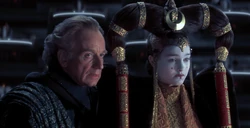
Queen Amidala's Vote of No Confidence was instrumental in Senator Sheev Palpatine's rise to power.
Senator Palpatine and Chancellor Valorum greeted Amidala upon her arrival to the capital. Though Valorum assured her of the Senate's distress over the situation, Palpatine warned her that neither the Senate nor the Chancellor were likely to intervene unless they made a change in leadership. As Naboo's galactic representative, Palpatine served as Amidala's advisor and confidant. He told her that the Senate was corrupt, and the Chancellor a figurehead to the bureaucrats. When the Trade Federation's delegates forced Valorum to adhere to bureaucratic procedure, Amidala countered by calling for a Vote of No Confidence in him, following Palpatine's advice despite her initial reluctance to denounce a strong supporter of her world.[9]
Believing the Republic no longer adhered to its founding principles, Amidala returned to her planet to liberate the people of Naboo without the Senate's intervention. Before leaving Coruscant, Palpatine informed her of his nomination to succeed Valorum. His competitors were Senator Bail Antilles of Alderaan and Senator Ainlee Teem of Malastare, but Palpatine assured Amidala that he would win the election through widespread sympathy for Naboo's plight. He vowed to dedicate his term to ending corruption, and Amidala implored him to restore compassion to the Senate.[9]
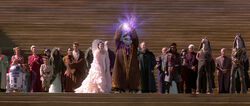
The victors of the Battle of Naboo celebrated their triumph in the liberated city of Theed.
Unable to count on Republic aid, Amidala turned to Naboo's Gungan population. Despite ill feelings between their segregated societies, the occupation of their shared homeworld allowed Amidala to mend their relationship through diplomacy. The Gungan Grand Army confronted the Trade Federation's battle droids while the Naboo Royal Space Fighter Corps launched an attack on the Saak'ak in orbit. The Gungans were forced to surrender after their defenses collapsed, and several Naboo pilots were killed in the space battle. However, Amidala's team infiltrated the Theed Royal Palace where they captured Gunray, and with the Saak'ak destroyed by Skywalker, the droids were deactivated. In the aftermath of the Battle of Naboo, Gunray was taken into Republic custody and the newly-elected Supreme Chancellor Sheev Palpatine arrived in Theed where he and the queen congratulated each other on their recent success. The new Chancellor said that they would work together bringing peace and prosperity to the Republic.[9]
Separatist Crisis
- "I will not let this Republic that has stood for a thousand years be split in two. My negotiations will not fail."
"If they do, you must realize that there aren't enough Jedi to protect the Republic. We're keepers of the peace, not soldiers." - ―Sheev Palpatine and Mace Windu
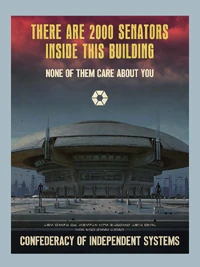
The Separatist Crisis reflected widespread disillusionment with the Republic.
Following the Naboo Crisis, the Trade Federation monopoly on the Outer Rim was broken, all while Supreme Chancellor Finis Valorum's political standing suffered from the crisis along with other scandals. In his wake, Palpatine was appointed to the position of Supreme Chancellor, eventually creating an image of himself as a mild-mannered servant of the common good, despite his true intentions. However, growing tensions between the Core and Outer Rim worlds gradually increased to the point where many believed that a war was imminent.[5] Foreseeing this conflict years before the Invasion of Naboo, Jedi Master Sifo-Dyas advocated for the creation of a new Republic army, only to be rejected by the Jedi High Council, who believed his ideas too extreme. Undeterred, Sifo-Dyas contacted the Kaminoans, known for their clone hatcheries, and secretly commissioned them to create a clone army, pretending to represent the Galactic Senate. Unbeknownst to Sifo-Dyas, Darth Sidious had earlier contacted Prime Minister Lama Su, and convinced him to implant a behavioral modification biochip into the clones during the third stage of their development to turn against the Jedi at a mere command.[50]
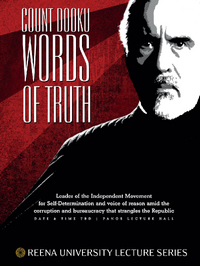
A former Jedi Master, Count Dooku led the Separatist movement against the Republic.
The dashing swordsman and political idealist Jedi Master Count Dooku, taking an eight-year leave of absence from the Jedi Order and now secretly the apprentice of Darth Sidious and dubbed Darth Tyranus,[8] paid the Pyke Syndicate to eliminate Sifo-Dyas over the planet of Oba Diah. With Sifo-Dyas originally heading to the planet in order to negotiate a dispute that could have resulted in a full-scale gang war on Coruscant, Sifo-Dyas was suddenly re-assigned to Felucia when his shuttle was abruptly shot down over the planet. Bringing his body to Felucia, where it was cremated by tribal inhabitants, Dooku managed to trick the Jedi Council into believing Sifo-Dyas had been killed by the Felucians,[50] all while erasing the existence of Kamino from the Jedi Archives.[8]
In the decade after the Invasion of Naboo, the whereabouts of Count Dooku were scarcely known, with many believing he merely wished to form an offshoot of the Jedi Order. In reality, Dooku manipulated galactic events to foment political turmoil on a variety of worlds including Kashyyyk, Sullust and Onderon. Seeking to create a southern Separatist sphere of influence by bringing Yag'Dhul and Sluis Van to his side, Dooku needed to persuade the now prosperous world of Eriadu to join the Separatists. However, Wilhuff Tarkin was pressured to declare his loyalties especially after Dooku commandeered a HoloNet station in the Raxus system and denounced the Galactic Republic, effectively setting the stage for the Separatist Crisis. Tarkin ultimately sided with the Galactic Republic in his stern belief that an inefficient yet unified galaxy was better than a fractured one.[5]
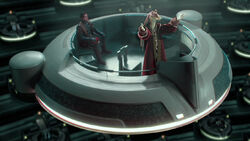
The Senate granted the chancellor emergency powers at the behest of Representative Jar Jar Binks.
Chancellor Palpatine's negotiations with the Separatists were unsuccessful, leading the Galactic Senate to consider the Military Creation Act. Senator Amidala led the opposition against the bill, believing it would make war between the Republic and the Separatists inevitable. Following an assassination attempt on Amidala, the chancellor ordered her to return to Naboo while the Jedi investigated the plot against her. Junior Representative Jar Jar Binks assumed her responsibilities on Coruscant for the duration of Amidala's absence. The Jedi's subsequent discovery of two secret armies, the clones and the battle droids, influenced the Senate's next actions. The Loyalists agreed that the Republic needed the clone army, yet they felt that the Senate would fail to pass the Military Creation Act before the Separatists' attacked the Republic with their droid forces. When Vice Chair Mas Amedda suggested that they resolve the crisis by bestowing emergency powers to Chancellor Palpatine, Representative Binks proposed as much to the Senate who passed his bill, allowing Palpatine to officially recognize the clone army as the Grand Army of the Republic. A self-proclaimed proponent of democracy and Republic patriot, Palpatine assured the senators that he intended to return the powers that they had given him after the crisis was over.[8]
The Clone Wars
- "I have to admit that without the clones it would not have been a victory."
"Victory? Victory, you say? Master Obi-Wan, not victory. The shroud of the dark side has fallen. Begun, the Clone War has." - ―Obi-Wan Kenobi and Yoda

The Battle of Geonosis was the first battle in the Clone Wars.
The Clone Wars began with the First Battle of Geonosis. Supported by the Republic Navy, the Grand Army of the Republic charged across the fields of Geonosis, serving under the Jedi Knights as they battled the Separatist Droid Army. Meanwhile, Poggle the Lesser's schematics for the Ultimate Weapon were transferred to Dooku who escaped the battle after dueling Skywalker, Kenobi and Grand Master Yoda. Simultaneously, the various members of the newly-founded Confederacy of Independent Systems evacuated the planet as Republic clone troopers gradually forced the droid army into full retreat. The battle was hailed as a Republic victory, although Yoda took the opposite position as he knew that war would spread across the galaxy. Count Dooku traveled to an industrial sector on Coruscant to inform his master that the war had begun as planned, all while the Jedi High Council pondered Dooku's warning that the Dark Lord of the Sith controlled the Senate.[8]
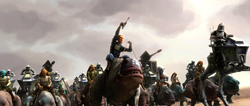
Twi'lek insurgents fought alongside Republic soldiers in the Battle of Ryloth.
In the aftermath of Geonosis, the deadly three-year conflict that engulfed the galaxy into chaos officially began, forcing more and more worlds to choose sides between the Galactic Republic and its clone army or the ever-expanding Confederacy of Independent Systems and its Separatist Droid Army. With the war well under way, numerous diplomatic envoys engaged in several attempts to sway local worlds to join the Galactic Republic, with Jedi Master Yoda seeking to win the support of the Toydarian King Katuunko, while Sith assassin Asajj Ventress sought to disrupt the meeting, and instead sought to win the support of the king to join the Confederacy.[51] The Republic also sent military aid and support to factions in need, such as Cham Syndulla's Twi'lek Resistance on Ryloth,[52] or to the Dugs of Malastare, whose lucrative fuel reserves were a great boon to the Republic Navy.[53] Numerous worlds such as Mandalore also attempted to maintain their neutrality, although they often were forced to seek aid from third parties in times of need.[8][27]
Throughout the Clone Wars, numerous attempts were made against Supreme Chancellor Palpatine's life, including an kidnapping attempt on Naboo masterminded by Count Dooku[54] as well as the hostage taking of members of the Galactic Senate by notorious bounty hunter Cad Bane.[55] However, political intrigue fueled not only the conflict, but also advances in weaponry and the development of equipment to enhance existing armed forces. Attempts at biological weapons were launched by Separatist scientist Nuvo Vindi, who attempted to re-create the ancient Blue Shadow Virus capable of killing millions across the galaxy,[56] while the Republic developed the experimental electro-proton bomb, which could send out an electric pulse upon detonation capable of deactivating an entire droid army.[53]
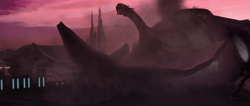
The Republic transported a Zillo Beast to Coruscant after the Battle of Malastare.
Following the Battle of Malastare, the Republic also attempted to create an impenetrable armor by unlocking the biological secrets of the Zillo Beast, an ancient creature from the Mid Rim, only to have the attempt end in failure, sending the beast on a rampage across Coruscant. After its death at the hands of a Jedi task force, the beast was secretly cloned by orders from the Supreme Chancellor himself.[57] In the meantime, the Republic developed a stealth ship capable of cloaking itself, as well as upgrading its standard Phase I clone trooper armor to the more sophisticated Phase II clone trooper armor prior to the Battle of Mon Cala.[58]

Republic clone troopers were the military arm of the Galactic Senate.
The Republic adopted the clone army to defeat the Separatists, but the clone troopers were also at the disposal of the Senate. The Coruscant Guard was formed by clone shock troopers stationed on the Republic capital;[59] senatorial delegates were accompanied by clone bodyguards;[54] and the clones became involved in the Republic's internal disputes by acting as enforcers of the Senate.[60]
The Senate Guard still accompanied dignitaries on off-world missions,[61] but as the war continued the Coruscant Guard became increasingly responsible for the security of the Supreme Chancellor[54] and the delegates of the Senate.[4] On one occasion, the Republic deployed a Jedi-led force of clone troopers to Orto Plutonia at the behest of one of its members, the Pantoran Assembly. The government of Pantora claimed sovereignty over the planet, which resulted in open conflict between the Pantorans and the native Talz. Although the clones served under the Jedi, they were also beholden to the authority of the Pantoran leader, Chairman Chi Cho, and the Pantoran senator Riyo Chuchi.[60]
Fall of the Republic
- "So this is how liberty dies…with thunderous applause."
- ―Padmé Amidala, on the end of the Galactic Republic

The Jedi Temple was the site of a terrorist attack against the Order.
The Grand Army of the Republic was led by Jedi Generals throughout the Clone Wars.[35] While many heroic actions were taken by the Jedi and those who served under them, inspiring the public with stories of bravery, war weariness only continued to grow as the years went by.[48] The Republic citizenry grew to believe that the Jedi had abandoned their role as peacekeepers,[62] and staged massive protests outside of the Jedi Temple as a result. Despite their waning influence in the galaxy, the Jedi continued to lead the Republic's forces but sustained many casualties in the process. Their role in the conflict was opposed not only by civilians,[63] but also the Republic officer Wilhuff Tarkin who wanted to revoke the Order's military authority, convinced that the Jedi Code was a hindrance on the Republic war effort.[64] Padawan Barriss Offee also disagreed with the Order's involvement in the Clone Wars, and staged a bombing in the Jedi Temple as protest, all while framing Ahsoka Tano of committing the act before being captured herself.[65]
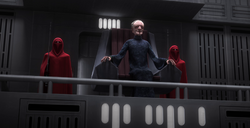
Chancellor Palpatine's wartime powers made him a dictator in all but name.
The war also served as a means for Sheev Palpatine to amass more emergency powers, cementing his position as Supreme Chancellor far longer than it technically allowed, all while continuing to centralize political and military authority within the Office of the Chancellor, which included putting the InterGalactic Banking Clan under the Chancellor's oversight.[4] By gaining wartime powers, Chancellor Palpatine was effectively a dictator.[66] The Separatist Shadowfeed operation, an attempt by Count Dooku to spread information on Republic defeats, making it appear as though a Separatist victory was inevitable, fueled public anxiety and consequently accelerated the militarization of the Republic over the course of the war.[5]
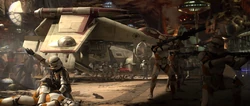
The Republic invaded Utapau with the goal of bringing a decisive end to the Clone Wars.
After nearly three years of constant warfare, the war reached its climax during the Battle of Coruscant, where both factions engaged in a massive naval and ground battle over the Republic's capital world. The confrontation ultimately saw the Republic dealing a severe blow to the Confederacy with the loss of a portion of its fleet as well as its head of state, Count Dooku, at the hands of Anakin Skywalker. Shortly afterwards, General Grievous met his end at the hands of Obi-Wan Kenobi during the Battle of Utapau. Yet even as the Republic pressed on with the Outer Rim Sieges, determined to bring an end to the civil war, the Jedi High Council had grown increasingly wary of Chancellor Palpatine. Over the course of the Clone Wars, the Chancellor's wartime authority reached unprecedented levels at the expense of the Senate, some of whom also grew concerned for the future of the Republic. As such, members of the Council and the Senate began to consider their options for the preservation of democracy. Whereas the Delegation of 2,000 sought to petition the Chancellor to relinquish his emergency powers, the Council contemplated the possibility of removing him by force and taking over the Senate in order to secure a peaceful transition of power.[2]
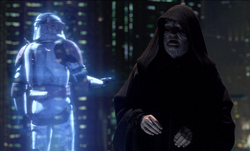
Palpatine was the Sith Lord Darth Sidious, whose machinations brought about the fall of the Jedi and the Republic.
Ultimately, their suspicion of the Chancellor was vindicated when Skywalker uncovered the truth: Sheev Palpatine and Darth Sidious, the Sith mastermind behind the Clone Wars, were one and the same. Acting swiftly on this revelation, the Council attempted to arrest the Sith Lord before his plan could come to fruition, consequently leading to a lightsaber duel in which Sidious struck down Agen Kolar, Saesee Tiin, and Kit Fisto before Mace Windu disarmed him. Given the Chancellor's control over the Senate and the courts, Windu deemed Sidious too dangerous to live. However, Skywalker argued that execution was contrary to the Jedi way, although his personal attachment to Amidala also influenced him at this critical point as he believed that Sidious could save her life. In a moment of desperation, Skywalker disarmed Windu, which allowed Sidious to kill the Jedi Order's champion with a torrent of Force lightning. Having chosen the path of the dark side, the fallen Jedi Knight became Darth Vader and subsequently led the attack on the Jedi Temple while Sidious issued Order 66 to the Grand Army, causing the clone troopers to execute their Jedi leaders across the galaxy.[2]
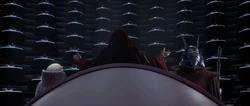
With the Jedi eliminated, Sidious declared himself Emperor of the Galactic Empire.
The Senate held an emergency session at the Chancellor's request. Sidious publicly denounced the Jedi Order; he accused them of plotting to assassinate him in order to take control of the Senate, and by extension, the Republic. Meanwhile, Vader undertook a mission to Mustafar where he personally executed the Separatist Council. With the Great Jedi Purge in effect, and the Separatists neutralized, Sidious proclaimed himself Galactic Emperor. The Galactic Republic officially became the Galactic Empire,[2] and democracy was supplanted by the fascist New Order.[14] While many senators cheered and applauded the birth of the Empire, Amidala and Organa quietly lamented the Republic's end.[2]
Vader deactivated the droid army soon after killing the Separatist leaders on Mustafar. The Clone Wars was over, and its conclusion marked the dawn of the Imperial Era.[2]
Legacy
Empire and rebirth
- "This is Master Obi-Wan Kenobi. I regret to report that both our Jedi Order and the Republic have fallen, with the dark shadow of the Empire rising to take their place. This message is a warning and a reminder for any surviving Jedi: trust in the Force. Do not return to the Temple. That time has passed, and our future is uncertain. Avoid Coruscant. Avoid detection. Be secret… but be strong. We will each be challenged: our trust, our faith, our friendships. But we must persevere and, in time, I believe a new hope will emerge. May the Force be with you always."
- ―Obi-Wan Kenobi's warning in the recall signal
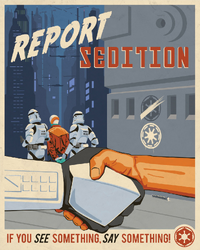
The Galactic Empire sought to erase all traces of the Galactic Republic.
In the decades after the dissolution of the Galactic Republic, numerous individuals still clung to the memory of the now Old Republic and its fabled Jedi warriors, while many individuals who knew the Jedi in person refused to believe the Emperor's account of a "Jedi Rebellion."[48][67] The Jedi Order that served the Republic would continue its legacy and endure during the Great Jedi Purge.[16]
Nevertheless, a majority of galactic citizens eventually came to believe and actively support this view, believing the Republic to have grown weak and corrupt, necessitating Palpatine's rise to power. In order to destroy the memory of the previous government, any visible reminder of the Old Republic was quickly removed, with many organizational changes altering the names of various locales and institutions, while architecture was molded to a more severe and dark aesthetic. With the renowned Galactic Senate being renamed the Imperial Senate and the Senate Plaza renamed Imperial Plaza and a giant statue of the Emperor erected in it, one could almost forget the Republic even existed.[5]
However, the memory of the Republic as a force of freedom and justice could never be fully destroyed as long as those who still believed in it lived, thus spurring numerous resistance movements throughout the Empire's reign such as the Free Ryloth Movement[68] and Berch Teller's rebel cell.[5] These displays of resistance eventually coalesced into the Alliance to Restore the Republic prior to the Battle of Yavin, where the Death Star was destroyed.[23] Subsequent battles included the Battle of Endor which saw the destruction of the second Death Star as well as the deaths of Sidious and Vader.[69] In the aftermath of their victory at Endor, the Alliance declared itself the New Republic as an ode to the Old Republic.[16]
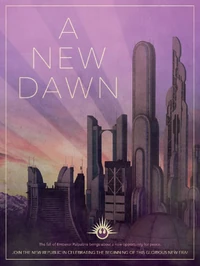
After the Emperor's death, the Rebel Alliance was reformed into the New Republic.
However, the New Republic disavowed some aspects of the Old Republic, particularly the legacy of its final years under the chancellery of Sheev Palpatine.[70] The word "Supreme" was removed from the title of Chancellor; Coruscant was stripped of its traditional role as the galactic capital, allowing other worlds to host the restored Galactic Senate on a rotating cycle; and the Military Disarmament Act reduced the New Republic Defense Force in the aftermath of the Galactic Civil War. Such efforts succeeded in convincing former Separatist worlds to support the New Republic,[71] but also led to political partisanship in the Senate where Populists favored the sovereignty of member worlds while Centrists lobbied to increase the central government's power and military spending.[70] Ultimately, the Centrist worlds seceded from the New Republic and joined the First Order,[72] a successor to the Galactic Empire,[73] resulting in the Cold War between the two galactic powers.[72]
The story of Old Republic Regent Hylemane Lightbringer and his supposed immortality would be remembered in history texts along with Old Republic music such as the Sestina of Imperator Vex, which would continue to be sung even in the months following the Battle of Endor.[16]
Posterity's judgment
- "Before the outbreak of war, the twilight of the Republic was an era of distractions, with citizens from all walks of life following escapist pursuits. Historians rebuke the people of this last age for being taken in by such circuses when their attentions should have been focused on the malfeasances and corruption in the Senate and other governing institutions."
- ―Janyor
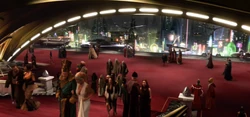
Historians rebuked the generation that witnessed the Republic's downfall, holding the people of this last era of peace responsible for the death of liberty.
Hailed as one of the greatest political achievements in the galaxy's history,[35] the Galactic Republic was described by the historian Janyor as "the Republic of legend, greater than distance or time." Although other versions existed in the ancient past, collectively known as the "Old Republic," posterity credited the modern Republic for delivering the galaxy from an age of darkness and, with the help of the Jedi Order, forging an era of peace that lasted for a thousand years until the advent of the Clone Wars. Historians romanticized the Age of the Republic, calling it the "last era of peace"—notwithstanding isolated conflicts, which were notably few and swiftly resolved by Jedi mediators—before the rise of vast warships and planet-killing superweapons.[14]
The Republic in its final years, however, was remembered with less fondness. Historians regarded the people of that time as a generation of apathy and indolence, in which galactic senators cared more about power and luxury than representing their constituents or addressing the perceived inefficiencies of the government. The civilian population was also seen as a contributing factor to the Republic's demise, with Core Worlders being more invested in podracing events in the distant Outer Rim Territories than the politics that caused dissatisfaction to fester and grow into the Separatist Crisis. Ultimately, historians rebuked this generation and held it responsible for the collapse of the "comfortable civilization" that defined the modern Galactic Republic.[14]
Organization
Politics
- "It's been my experience that senators are only focused on pleasing those who fund their campaigns—and they are more than willing to forget the niceties of democracy to get those funds."
- ―Obi-Wan Kenobi
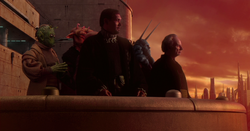
The Supreme Chancellor was the elected leader of the Galactic Senate.
The government of the Galactic Republic consisted of the Office of the Chancellor, the Galactic Senate, and the Judicial Department. Executive power was vested in the Supreme Chancellor, although this office was largely powerless and hampered by bureaucratic procedure, particularly during the chancellery of Finis Valorum. Nevertheless, the Chancellor had the authority to issue executive orders summoning the Senate to an emergency session[9] or sending senators away from Coruscant for security reasons.[8]
The chancellery of Sheev Palpatine shifted the balance of power in favor of the Chancellor's office, a consequence of the wartime powers that the Senate gave its leader on the eve of the Clone Wars.[8] As the conflict spread across the galaxy, Palpatine's chancellery gradually morphed into a dictatorship[66] with control over both the Senate and the Republic courts. Near the war's end, Palpatine appointed Anakin Skywalker as his own personal representative on the Jedi High Council, which the Jedi considered an overreaching exercise of the Chancellor's authority. By then, Palpatine had managed to remain in power by exceeding the term limits of his office, an action that the Senate supported.[2]
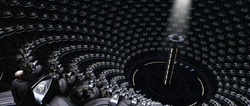
The Galactic Senate was the governing body of the Republic.
Prior to Palpatine's rise to power, the Galactic Senate was the ruling body of the Republic. Many worlds across the galaxy were represented in the Senate which was headquartered on Coruscant, capital of the Republic.[74] At the height of its reign, the Senate's power eclipsed that of the Supreme Chancellor[9] but it had also become stagnant under unbridled corruption and layers of bureaucracy.[74] As more politicians grew enamored with the comforts of their office, prioritizing power and wealth over their constituents' needs, average citizens questioned if the Republic and its high taxes were worth the membership.[14] The Jedi had also grown distrustful towards senators and regarded their motives with skepticism,[8] notwithstanding the Order's allegiance to the Senate as a whole.[2]
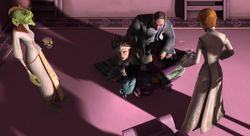
Conflicting ideologies led to factionalism, intrigue and murder in the Senate.
With the Senate hamstrung by political infighting and a strict adherence to protocol, it failed to bring swift resolutions to either the Invasion of Naboo[9] or the Separatist Crisis.[8] In lieu of a diplomatic solution, the Senate rallied under Chancellor Palpatine's leadership. However, the decision to grant him emergency powers eroded their authority, allowing Palpatine to amass even more power at the expense of the Senate. At the time of the Clone Wars, the Senate was divided between supporters of the war effort and pacifists who sought a peaceful end to the fighting.[74]
The Judicial Department was an umbrella department over the Republic courts, including the Supreme Court, the highest court of law in the Republic.[7] Its authority also extended over the Judicial Forces[5] and the Republic Office of Criminal Investigations.[7] Like its legislative counterpart, however, the courts were mired by a stagnant bureaucracy and was known to be even more indecisive than the Senate.[9] Despite the arrest of Nute Gunray, multiple trials in the Supreme Court failed to remove him as leader of the Trade Federation to the dismay of the Naboo government.[8]
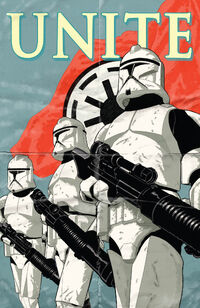
Clone troopers were used as tools of political propaganda during the Clone Wars.
Propaganda in the Galactic Republic had long served to sway public opinion in favor of Republic policies, from expanding into the Outer Rim Territories, to waging a pan-galactic war against the Separatists. One such propaganda tool was the Commission for the Protection of the Republic (COMPOR). Formed in the early days of the Clone Wars, COMPOR existed as a pro-Republic populist movement. As such, the organization's mission was twofold: to promote patriotism in the Republic, and to brand the Separatists as traitors. This goal was achieved through the artwork of Donclode Onstruss, Hamma Elad, and other artists associated with COMPOR.[14]
Throughout the conflict, COMPOR propagandists sought to sustain the war effort by keeping public opinion on the side of the Republic's military forces and their commander-in-chief, respectively the clone army and Supreme Chancellor Sheev Palpatine. Following an early attempt to utilize the Jedi Order as a propaganda tool, COMPOR focused increasingly on the Grand Army of the Republic, portraying clone troopers as a symbol of unity that the citizeny was encouraged to support. In regard to the Separatists, COMPOR depicted their leaders as icons of "evil," specifically General Grievous and Count Dooku. Using loyalty to the Republic and fear of the Separatists, COMPOR lobbied the Galactic Senate to give more emergency powers to Chancellor Palpatine whom they supported as a wartime leader.[14]
Foreign policy
- "If we are successful, you'll have Maul and I'll have Mandalore."
"If Republic forces aid you in your assault, it will break treaties that are a hundred years old. We will effectively be drawn into yet another war." - ―Bo-Katan Kryze and Obi-Wan Kenobi
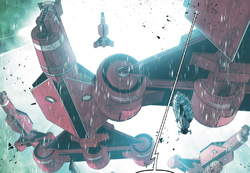
The Republic intervened in the internal conflict of an independent world, believing Carnelion IV possessed valuable resources.
The Senate did not intervene in the Open-Closed War on Carnelion IV because the planet was not part of the Galactic Republic. Carnelion IV did not join the Republic because the Senate had little economic interests in the planet.[75] The Republic's diplomatic fleet subsequently forced a ceasefire to the Open-Closed War after Kenobi claimed that the planet had high concentrations of tibanna gas in its atmosphere in order to bring an end to the long-running conflict.[76]
During the Clone Wars, the Republic tolerated the political stance of neutral governments, among which were the New Mandalorians.[27] Their leader, Duchess Satine Kryze, was a staunch pacifist who sought to keep her homeworld and it allies out of the conflict through her capacity as head of the Council of Neutral Systems.[77] The Republic and Mandalore coexisted through treaties over a century old by the time of the Clone Wars,[78] though by then the Senate sanctioned a plan to invade the planet Mandalore, having grown to believe that Kryze's pacifist government could not protect the Mandalorian people from the Death Watch movement. However, the invasion was called off due to evidence that the Senate's pretext for war—the testimony of Deputy Minister Jerec—had been falsified.[79]
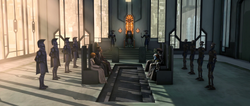
The neutral world of Mandalore hosted a failed peace conference between the Republic and the Separatists.
Mandalore was the site of attempted peace talks between the Galactic Republic and the Confederacy of Independent Systems, with Duchess Satine overseeing the conference. Both governments dispatched their delegates to the neutral world in addition to Republic Senate Commandos and Separatist BX-series droid commandos. Negotiations broke down, however, allowing the war to continue without interruption.[61]
Supreme Chancellor Sheev Palpatine claimed that the Republic was willing to assist a neutral star system during their times of crisis,[80] but the Republic declined military aid to neutral governments as a matter of policy.[78] If a government broke its neutrality by siding with the Separatist Alliance, it risked becoming an enemy of the Republic. When the InterGalactic Banking Clan began favoring the Separatists at the Republic's expense, the Republic retaliated by deploying an invasion force to occupy the planet Scipio.[4]
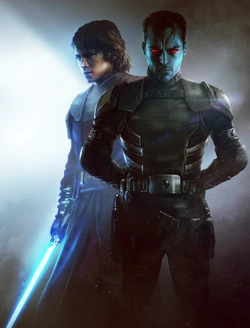
Mitth'raw'nuruodo did not see the Galactic Republic as a suitable ally for the Chiss Ascendancy, despite working with Anakin Skywalker.
Despite Mandalore's neutrality, Ahsoka Tano and Bo-Katan Kryze requested the Grand Army's support to depose the Shadow Collective that supplanted Satine Kryze's regime. Although the Jedi were concerned about getting drawn into the Mandalorian civil war while in the midst of the ongoing Clone Wars, especially when the world in question was still officially neutral, they permitted a division of the 501st Legion to support the Nite Owls in the Siege of Mandalore.[78]
During the Clone Wars, the Republic made indirect contact with the Chiss Ascendancy through Jedi General Anakin Skywalker's encounter with Senior Captain Mitth'raw'nuruodo "Thrawn," an officer of the Chiss Expansionary Defense Fleet. Thrawn had been tasked with exploring the Outer Rim by the time the Ascendancy, having discovered a mysterious threat in the Unknown Regions, sought to assess the Galactic Republic as a potential ally. Thrawn gathered intelligence on the Clone Wars through his interaction with Skywalker, who, in turn, recruited the Chiss officer's help with rescuing Senator Padmé Amidala. Skywalker was impressed by Thrawn during their time working together, which he later reported to Chancellor Palpatine. Thrawn was unimpressed by the Republic, however, believing democracy to be an inefficient form of government.[81]
Defense
Republic Defense Coalition
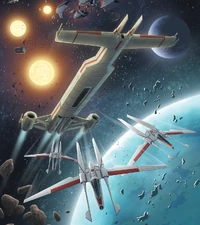
The Republic Defense Coalition was an interplanetary alliance between the Republic's member worlds.
The Republic Defense Coalition, also known as the RDC, was organized as a small peacekeeping fleet that defended the Galactic Republic's interests during the High Republic Era. The RDC was bound together as an organization through defense treaties signed by the Republic's member worlds, including Alderaan and Chandrila. The treaties that created the RDC gave it the ability to allocate starships and personnel from the signatory worlds in times of emergency. These resources would remain under the RDC's control until the threat was neutralized, after which they would be returned to their homeworlds.[43]
The fleet consisted of several starship types such as Emissary-class cruisers, Pacifier-class sector patrol cruisers, the Longbeam, and Z-28 Skywing starfighters. Despite the existence of the RDC, the Republic was at the height of an era of peace that had lasted for centuries, with neither the Hutts nor the Mandalorians posing a threat. As a result, the Emissary-class resembled a work of art, its crenellations and spires designed to be symbolic of the Republic in a state of tranquility. The RDC operated alongside the Jedi Order as well, allowing the peacekeepers to store their personalized starfighters, the Jedi Vectors, in the hangars of its Emissary-class cruisers.[43]
Judicial Forces
- "The Judicials are at the end of their tenure, in any case, as the Jedi seem to have become the Senate's arbiters of choice."
- ―Sheev Palpatine, to Wilhuff Tarkin
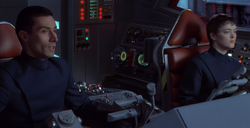
Judicials were non-Jedi peace officers of the Republic.
The Judicial Forces were the armed peacekeeping forces of the Galactic Republic Judicial Department.[5] While the Jedi helped to maintain order and peace under the authority of the Galactic Senate, they were not considered a standing military.[75] As officers of the government, Judicials had access to Consular-class space cruisers.[9] The distinctive design and color of Republic cruisers identified them as diplomatic vessels,[82] often used by delegates of the Galactic Senate, agents of the Supreme Chancellor, or members of the Jedi Order.[83]
In the last decades of the Republic, the Jedi effectively supplanted the Judicial Forces as arbiters of the Senate.[5] Judicials therefore acted in a supporting capacity, escorting Jedi ambassadors on their offworld missions.[9]
Republic Military
- "As my first act with this new authority, I will create a Grand Army of the Republic to counter the increasing threats of the Separatists."
- ―Sheev Palpatine
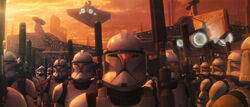
The Grand Army of the Republic was composed of clone troopers.
Towards the end of the Separatist Crisis, the Galactic Senate passed the Military Creation Act, which led to the creation of the Grand Army of the Republic and the Republic Navy.[7] Outfitted with armor weapons and gear,[84] clone troopers were the backbone of the Republic Military. Bred for loyalty and combat, clones symbolized the future of galactic warfare at the time of the Clone Wars, the conflict that derived its name from their ranks. The training that they experienced molded the clone troopers into a highly efficient army,[85] and because they retained the ability to think creatively despite their stunted independence,[8] they were considered far superior to their droid counterparts. In their first battle against the Separatist Droid Army, the Grand Army displayed a level of military strength unseen in the history of the galaxy.[85]
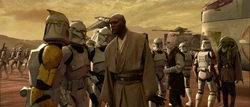
Clone troopers served under the command of Jedi Generals.
Clones were, by and large, proud to serve as soldiers of the Galactic Republic. Although a minority committed treasonous acts such as desertion or espionage for the Separatists, most were steadfast in their allegiance and many troopers sacrificed themselves for the Republic. They were loyal to the Supreme Chancellor, but also the Jedi who served as generals in the Grand Army of the Republic.[85] A strong sense of trust developed between Jedi generals and clone commanders over the long campaigns of the Clone Wars.[35]
There were several types of clone soldiers that stood as a breed apart from their rank-and-file brethren. The Advanced Recon Commandos, for example, were noted for their elite status and capacity for independent thinking. Another specialized class was the clone commando—elite operatives trained for missions too complex for other soldiers.[84]
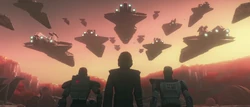
The Republic Navy utilized Venator-class Star Destroyers as capital ships.
Along with the Acclamator-class transgalactic military assault ship and other support vessels, the Venator-class Star Destroyer was the mainstay warship of the Republic Navy.[86] Part cargo transport and part troop carrier, the Venator was also developed for ship-to-ship combat. The Venator notably contained a large hangar for housing state-of the-art Republic starfighters.[87]
The Republic Navy fielded various ships over the course of the war.[2] Early models included the V-19 Torrent starfighter[86] and the Clone Z-95 Headhunter.[88] New fighters were added to the Navy in the final months of the war.[2] The Aggressive ReConnaissance-170 starfighter represented the latest design in starfighter technology,[89] while the Alpha-3 Nimbus-class V-wing starfighters incorporated the design improvements of the ARC-170 an the earlier V-19.[90]
Jedi Order
- "They have numbers on their side. And the faith of the Republic."
"For the moment. In time, and with careful planning, they will lose both." - ―Darth Maul and Darth Sidious, on the Jedi Order
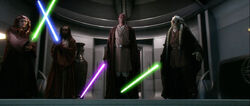
The Jedi Order served the Galactic Republic as guardians of peace and justice.
The Galactic Republic placed its faith in the Jedi Order,[91] relying on Jedi Knights to safeguard peace and justice in the realm.[39] It was with the Order's aid that the Galactic Senate was able to govern the galaxy for a thousand years.[73] The Order's allegiance was to the Senate,[2] though by the final years of the Republic, the Jedi regarded politics with skepticism, believing politicians were untrustworthy. Nonetheless, the Order maintained a close relationship with the Republic to uphold their mandate as keepers of the peace.[8]
The Order could identify Force-sensitives shortly after their birth, as long as they were born within the Republic.[9] Offering a Force-sensitive child to the Order was considered a great honor by the majority of the Republic's population, as well as a personal sacrifice.[35] The Order became the true family of every child brought into its ranks,[92] and Jedi doctrine did not permit them to know their birth families. Therefore, familial attachment was surrendered in service to the Order.[35]

With the fall of the Jedi Order, the Galactic Republic was transformed into the Galactic Empire.
While the Order numbered ten-thousand strong at the height of the Clone Wars,[93] their ranks were insufficient for the defense of the Republic. Therefore, the Jedi were compelled to lead the clone army[8] with the aim of bringing a swift and decisive end to the conflict between the Republic and the Separatists.[50] With no end to the war in sight, however, anti-war protests broke out on Coruscant where Republic citizens decried their leaders and the Jedi alike.[1] When the Clone Wars ended, Darth Sidious accused the Order of staging a rebellion to overthrow the Senate and their chancellor. The Senate supported the chancellor's actions, which included the purging of the Order followed by the Republic's reorganization into the Galactic Empire.[2]
Economy
- "The Republic is near bankruptcy due to the cost of this war!"
- ―Bail Organa
The Republic credit was the currency of the Galactic Republic. Beyond Republic space, however, credits had no value on frontier worlds like Tatooine.[9]
The Republic possessed immense economic power,[94] having maintained peace—with the aid of the Jedi Knights—throughout the known galaxy for almost a millennium. Peace, in turn, promoted commerce. Under the Republic's protection, Naboo and other culturally rich worlds were able to profit from lucrative tourism.[14]
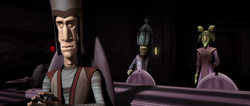
Corporations possessed considerable influence in galactic politics during the era of the Republic.
The business sector experienced an exponential growth in wealth and influence through widespread commercialism, with massive corporations funneling substantial amounts of capital into advertising their essential services to the wider galaxy. This unbridled "brand-building" initiative generated steady profits for vast enterprises like the Trade Federation.[14]
The Republic's expansion into the Outer Rim Territories proved lucrative to both the galactic government and the private sector. Eleven Star Marketing, a subsidiary of the Trade Federation, worked closely with the Republic Ministry of Economic Development to propagandize the exploration and colonization of the Outer Rim, convincing the lower class citizens of the Inner Rim to see the galactic frontier as an opportunity for profit. This arrangement would entangle Republic politicians with corporate lobbyists, both of which profited from the flow of settlers who had to pay tariffs and registration fees in order to reach the Outer Rim through one of the Federation's hyperspace routes.[14]
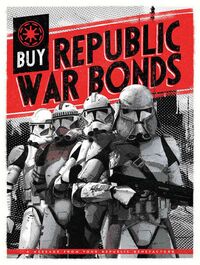
The Republic filled its war chest by encouraging its citizens to buy war bonds.
The Separatist Crisis had a significant impact on the Republic economy, with major worlds like Serenno, Raxus, and Onderon seceding from the pan-galactic union. As a result, the Republic lost access to the resources and tax revenue of the Separatist worlds. Diminished taxation revenue only compounded the Republic's debt, throwing the Senate into a crisis that ultimately led to open war between the Republic and the Separatist Alliance.[14]
The Clone Wars disrupted the galactic economy as the Senate exhausted its options to fund the Grand Army of the Republic while staving off bankruptcy.[95] The government urged its people to buy war bonds, using propaganda to convince the citizenry that it was their patriotic duty to give financial support to the war effort. In addition, the Republic sought to keep its war chest filled by imposing higher taxes on civilian skylanes, however unprecedented it was on cosmopolitan worlds like Coruscant.[14]
The Senate also weighed the need for additional clone troopers against the corresponding cost of growing supplemental units to replenish the Grand Army's ranks.[95] Funding the military had all but bankrupted the Republic treasury, which, in turn, shut down some of the basic services that the Republic had always provided for civilians who lived in the lower levels of Coruscant.[96]
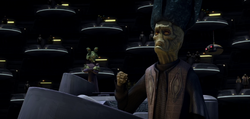
The Senate voted in favor of deregulating the banks in order to continue financing the Republic war effort.
The Republic imposed regulations on the banking industry prior to the Clone Wars, but the war's increasing cost led the Senate to consider deregulating the banks in order to access new lines of credit. After much debate, the Senate passed the Republic financial reform bill. The banks were deregulated, and the Republic submitted applications for further loans to support the production of more clone units.[95]
Following the Republic invasion of Scipio, the InterGalactic Banking Clan surrendered its financial assets to the office of Supreme Chancellor Sheev Palpatine. As a result, the Republic gained direct control over one of the galaxy's most influential commerce guilds.[97]
Though the Clone Wars had exacted a heavy toll on the Republic treasury,[14] the Republic remained a powerful economic force in the galaxy.[94] The Separatist Alliance, while supported by the resources of corporate barons,[14] was eventually overwhelmed by the economic and military power of the Republic.[94]
Science and technology
- "I assure you, sir, that this bomb only works on droids."
- ―Sionver Boll
The Galactic Republic invested in aesthetics and technological advancements for the starship industry. During the Republic's reign, starships were designed to be aesthetically pleasing in order to meet the customers' demand for "style and elegance" in their vessels. Craftsmanship, however, gave way to practicality as the Republic transitioned into the Galactic Empire, leading to the decline of sleek lines in favor of harsh uniformity, mass production, and sheer size.[35]
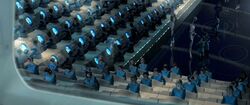
Millions of identical clones were bred to fight as soldiers of the Republic.
Cloning was a science in which an organism was "genetically duplicated into one or more identical copies." While neither the Senate nor the Jedi had any knowledge of the clone army's development prior to the Clone Wars, the Republic became heavily invested in the field of genetics throughout its conflict with the Separatists. The Kaminoans used their skills to transform the science of cloning into big business, resulting in the mass production of clone troopers who numbered in the millions. Their expertise all but perfected the art of genetic duplication. However, cloning humans was still a flawed science that occasionally produced aberrations. Nevertheless, the Kaminoans' cloning methods made it possible to alter clones at the genetic level, making them more docile and age twice as fast as natural-born humans.[35] They were also just as capable of engineering a clone for the purpose of pure genetic replication, giving it neither growth acceleration nor behavioral modification for greater docility.[8]
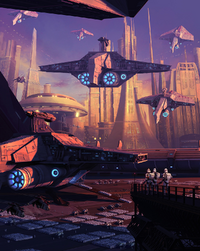
The Clone Wars drove the Republic's technological advancement.
The Clone Wars gave the Republic an incentive to spearhead technological innovation in spacecraft and terrestrial transportation for military purposes. The result was a legacy with far-reaching effects in the industry of science and technology. The Star Destroyer, the most visible representative of modern military capital ships, originated with the development of the Republic Navy's Venator-class Star Destroyer. The X-wing starfighter evolved from the Z-95 Headhunter; the BTL Y-wing starfighter was developed during the Clone Wars, and was still considered relevant long after the Republic's time. The Republic developed all terrain walkers, including the six-legged All Terrain Tactical Enforcer, as a response to the Separatist Armored Assault Tank and other droid battle tanks. This in turn influenced the developmental design of far larger vehicles, such as the Imperial All Terrain Armored Transport and the First Order All Terrain MegaCaliber Six, than what the Republic fielded in the Clone Wars.[35]
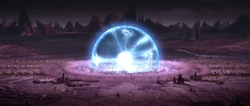
The electro-proton bomb was capable of destroying an army of droids in a single attack.
The Republic employed brilliant scientists, such as Doctor Sionver Boll[98] and Doctor Nala Se,[99] who contributed their expertise to the war effort against the Separatists.[53][100] Boll developed the electro-proton bomb,[98] an experimental explosive device capable of generating a massive burst of electromagnetic pulse energy to disable battle droids and any other form of technology.[53] Nala Se was the foremost scientist in the field of cloning; she supervised the development of the Republic's clone army,[99] although Boll was also familiar with cloning as Chancellor Palpatine ordered her to clone a dead Zillo Beast.[57]
The Republic Special Weapons Group was formed to oversee the development of military technology more advanced than conventional weapons of warfare.[101] The group was composed of technologists like Wilhuff Tarkin and Orson Callan Krennic;[6] using the Geonosian' schematics for a moon-sized battle station, they began implementing plans to construct the ultimate weapon. Their work continued after the Republic fell, and after years of delay the DS-1 Death Star Mobile Battle Station was made operational by the Empire. Both its size and power inspired the creation of more advanced weapons with the capacity to destroy planets, from the Imperial DS-2 Death Star II Mobile Battle Station to the First Order's Starkiller Base and the axial superlaser cannons of the Final Order's Xyston-class Star Destroyers.[35]
Society and culture
Civilization
- "Tales of its founding have been occluded by the haze of intervening millennia, and its rebirth a thousand years ago was regarded as the latest evolution in an unending cycle. Like the greatest of trees, however, the Republic's decline began from within, with a deep rot that was not apparent until it was too late."
- ―Janyor
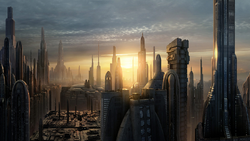
The Core Worlds represented the wealthiest and most prestigious region in the Galactic Republic.
The Galactic Republic governed the galaxy as a democratic union,[1] and as such, it featured a diverse society of humans and various alien species.[14] Coruscant in particular was emblematic of Republic society with its diverse mix of citizens and culture, making the Republic capital the "vibrant heart" of the galaxy.[94]
The Core Worlds, where Coruscant was located, was home to the most developed systems in the Republic. Various Core planets served as capitals for galactic governments such as the Old Republic, the Empire, and the New Republic. The prosperity of the Core made its worlds the wealthiest and most prestigious members of the Republic, though it was also a source of tension between the Core and the more distant regions of the galaxy. People who lived outside of the Core generally viewed "Core Worlders" as arrogant, entitled, and apathetic to the well-being and needs of other regions. A common criticism of Republic politics was that the system disproportionately favored the Core Worlds to the point of ignoring the rest of the galaxy.[35]
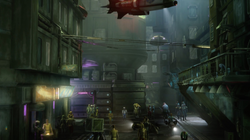
The Republic capital's lower levels were ridden with crime and poverty.
Coruscant was perceived as perpetuating the Core Worlds' reputation for extreme wealth and privilege. Notwithstanding its unique status as the galactic capital, the whole planet was covered by a city of levels built upon levels throughout the ages of galactic history. The tallest skyscrapers rose over five-thousand levels above the planet's natural surface, and only those who could afford to live in the upper city had access to the comfortable and luxurious lifestyle for which Coruscant was famous. The disparity was such that the lower levels were notorious for widespread crime, poverty, and being devoid of natural sunlight.[35]
Republic architecture was an architectural style that demonstrated sweeping lines. This particular design was prominently featured on the city-covered planet of Coruscant, although by the time of the Clone Wars, the Republic gradually adopted a brutalist or bold form of architecture. Introduced by military architects such as Orson Krennic, it ultimately supplanted the Republic style as the dominant architectural form of the Galactic Empire.[102]
Galactic Basic was the most prevalent language in the Republic,[103] spoken primarily by humans[104] and the Pantorans.[105] A heavily accented dialect of Basic, with many differences in grammar and vocabulary, was spoken by the Gungans of Naboo.[9]
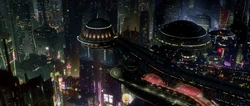
Republic citizens turned away from galactic politics to follow escapist pursuits.
The peaceful age of the Republic allowed the people of the galaxy to pursue leisure activities, some of which achieved galactic-level attention. The Boonta Eve Classic, while based on the independent Outer Rim world of Tatooine, beyond the Republic frontier, received coverage and attention as far as the Core Worlds. Prior to the Clone Wars, the Republic's twilight years became an era of escapism as citizens of all classes sought entertaining distractions from their daily lives. Professional podrace circuits and other circuses diverted the people's attention from the growing corruption that permeated the Galactic Senate. Nevertheless, the general public's fascination with various forms of entertainment was driven by an innate desire for stories about good versus evil and situations of escalating danger.[14]
The Jedi Order eschewed prestige and celebrity, making them mysterious to the Republic they served.
Whereas the Republic evolved through the centuries of its existence, the Jedi Order remained rooted in its ancient traditions, effectively putting the Jedi Code at odds with a galactic society that strongly favored the future over the past. The inhabitants of the Core Worlds became fixated on notions of fame and fashion, and had little interest in Jedi principles like faith and tradition. The Order maintained its place in the Republic by relying on historic precedent, serving as keepers of peace and justice. Unlike corporate institutions that marketed their services to the greater galaxy, the Order had little desire to promote itself through image-building. Aside from those who witnessed the Jedi's heroics[106] and were awed by their Force powers, the Order and its ways were forever mysterious to the majority of the Republic citizenry. The Jedi were seen by the public as an order of mystics at best and, at worst, regarded as a zealous sect of warmongers.[14]
A variant of the Republic crest was used during the Clone Wars.
As a result of territorial expansion, the Republic developed a sense of manifest destiny. This cultural belief was cultivated by Republic propagandists who sought to foster civic pride among the populace so that they would ultimately feel duty-bound to support the Republic's expansion from rim to rim. There was an exponential growth in Republic patriotism due to the Clone Wars and the accompanying propaganda that promoted loyalty to the state. Patriotic messages stirred an entire generation into action; however, they could not enlist in the Grand Army as its ranks were exclusive to clone troopers. Nevertheless, Republic citizens felt obliged to do their part by purchasing war bonds, reporting acts of treason, and making sacrifices to support the war effort.[14] The Republic crest, the symbol of a united galaxy under the Force,[107] was emblazoned on military war machines and heraldry, featuring more prominently than before.[14]
Although the Republic expanded into the Outer Rim Territories, the region was too underdeveloped to have the same stability as the Core Worlds. As the galaxy's largest region, the Outer Rim featured a myriad of diversity through its various planets and species. The Republic government had little oversight over the Outer Rim due to the region's distance from the Core, and as such the Outer Rim remained known for its lawless, sparsely populated, and primitive worlds. Republic law was virtually non-existent in the Outer Rim; as a result, bounty hunters, outlaws and smugglers were able to operate with impunity,[35] and slavery was still practiced in spite of the Republic's anti-slave laws.[9]
Xenophobia
- "Under Gunray's tenure, the Trade Federation would loudly counter such claims as common anti-Neimoidian prejudice."
- ―Janyor
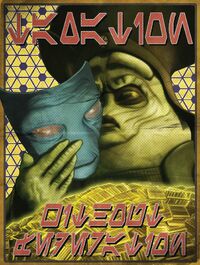
A popular stereotype of the Neimoidian race was the fat plutocrat who embodied greed and treachery.
Xenophobia was an issue in a society as diverse as the Republic. Although the Republic officially promoted unity among its member worlds[14] and outlawed the enslavement of sentient species,[9] some people were subjected to racial stereotypes. Neimoidians, for example, were considered obese, duplicitous and avaricious by some, including those who harbored anti-corporate views. This perception of their race was a product of Neimoidian culture, which cultivated a "survival of the fittest" mentality in Neimoidian younglings.[14]
The Trade Federation used xenophobic sentiments as a means to silence its critics, insinuating that those who sought to curtail the Federation's massive influence were prejudiced towards its Neimoidian leaders. The Muuns likewise had an image problem due to their monopoly in the InterGalactic Banking Clan. In general Muuns saw little need to build a relationship of stability and trust with the galaxy; they simply assumed that their place in society was to continue dominating galactic finances. Their cultural standards informed their business practices; therefore, Muun-sponsored advertisements were viewed as "distant and disconnected."[14]
During the Clone Wars, anti-alien prejudice grew as a result of the non-human races that constituted the Confederacy of Independent Systems. Vice Chancellor Mas Amedda sought to promote the Republic's multicultural aspect, having taken notice of the attention given to human citizens by the Republic media. Rather than reporting on Amedda's effort to showcase Republic diversity, HoloNet News outlets focused on the Vice Chancellor's self-inclusion as the sole Chagrian in an assembly of various aliens. The populace decried Amedda's message of strength and unity, and considered him an egocentric narcissist.[14]
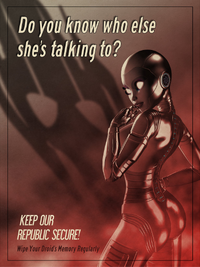
The Clone Wars fueled the Republic population's anti-droid sentiment.
The Clone Wars also inflamed the population's anti-droid sentiment to new levels due in no small part to the Separatists' reliance on battle droids. Droids had long become commonplace in galactic society, and though machines had always been the property of organics, the war cemented the view that droids were an existential threat to biological life. The Republic capitalized on this sentiment, using propaganda to illustrate droids as ruthless and dangerous tools of destruction. While the the concept of "droid terror" was embodied by battlefield machines, such as the B1-series battle droid, B2-series super battle droid and the droideka, administrative aide droids were viewed as a different kind of "droid threat" to Republic security. There was a growing fear among the Core's affluent population that the personal assistant droids of businessbeings and government administrators could be co-opted through spyware and used for Separatist espionage.[14]
Despite the Jedi Order's millennia of service to the Republic,[35] there was widespread anti-Jedi sentiment as a result of the Clone Wars.[14] The Sith plotted to undermine the relationship between the Republic citizenry and their Jedi guardians,[91] using the Clone Wars to shake the Republic's faith in the Order.[14] The Order fought hard to bring a swift and decisive end to the conflict,[2] but many citizens believed that the Jedi were warmongers. This perception was able to grow due in part to the Jedi's reluctance to accept accolades or embrace the fame of their status. It was the Order's preference to serve but not engage the populace; as such, the population's anti-Jedi views were the result of the Order's cultural absence as opposed to an actual refutation of their ways.[14]
Astrography
- "Republic wordsmiths and artists collaborated to create a sense of civic duty, of manifest destiny, and of deep obligation to spread the Republic banner from Rim to Rim."
- ―Janyor

Coruscant, the capital of the Republic, was located in the heart of the Core Worlds.
With Coruscant—birthplace of the human species[108]—as its capital,[14] the expansion of the Galactic Republic occurred along pioneering hyperspace routes. Survey teams established navigational beacons in outlying territories such as the Tertiary Usaita system,[109] allowing colonists from the Core Worlds to venture outward towards the Outer Rim in search of opportunity and a better life.[110]
The Galactic Republic existed across the known galaxy, stretching from the Core Worlds to the Outer Rim Territories. The Core Worlds was the heartland of the Republic, home to cosmopolitan worlds such as Coruscant[14] and Hosnian Prime[111] as well as Alderaan, one of the oldest and most prestigious planets in the Republic.[112] Over time, Republic expansionism led to the annexation of new member worlds.[14] The planet Naboo, located in the Mid Rim, was annexed by the Republic[54] in 867 BBY.[113]
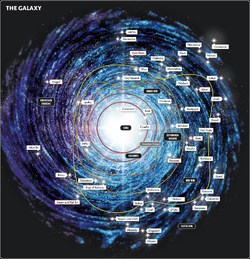
The Galactic Republic was a democratic union that spanned across the known galaxy for a thousand years.
The Republic exerted most of its power from the Core Worlds to the borders of the Mid Rim, to the extent that corporations conducted their legally dubious practices in regions where the Republic held little sway. Faced with issues like overpopulation and poverty among the lower classes, the Republic turned its attention to the Outer Rim, adopting a policy of expansion toward the uncharted territories of the known galaxy's farthest frontier. Those who inhabited the congested worlds of the galactic core were beckoned into deep space by political and corporate sponsored messages of life filled with adventure and mystery.[14]
Although the Republic opposed secession, it effectively lost control over the territories that formed the Separatist Alliance. Its territorial extent changed numerous times over the course of the Clone Wars, with worlds lost and reclaimed by the Grand Army of the Republic. However, the Republic also gained new territory as a result of the war. Geonosis, the planet where the Separatist Droid Army was secretly constructed, existed beyond the Republic's borders.[14] The Republic Military occupied the Geonosian homeworld after the First Battle of Geonosis, and subsequently returned to reconquer the planet after it fell back under Separatist control.[7] The Kaminoan government formally joined the Republic; as such, Kamino[14]—an extragalactic planet[114]—was accorded full representation in the Galactic Senate, having supplied the Republic with its clone industry.[14]
Behind the scenes
The Galactic Republic was first mentioned in the new Star Wars canon as the "Old Republic" through the 1977 film Star Wars: Episode IV A New Hope, directed by George Lucas.[23] The entity first appeared and was first identified as the "Galactic Republic" in the 1999 film Star Wars: Episode I The Phantom Menace, also directed by Lucas.[9]
Appearances
Non-canon appearances
- William Shakespeare's The Phantom of Menace: Star Wars Part the First
- LEGO Star Wars: Droid Tales Episodes I-III (In flashback(s))
- "All I Want For Life Day"
 LEGO Star Wars: The Freemaker Adventures — "A Hero Discovered" (Mentioned only)
LEGO Star Wars: The Freemaker Adventures — "A Hero Discovered" (Mentioned only) LEGO Star Wars: The Freemaker Adventures — "Zander's Joyride" (Mentioned only)
LEGO Star Wars: The Freemaker Adventures — "Zander's Joyride" (Mentioned only) LEGO Star Wars: The Freemaker Adventures — "The Storms of Taul" (Mentioned only)
LEGO Star Wars: The Freemaker Adventures — "The Storms of Taul" (Mentioned only) LEGO Star Wars: Droid Tales — "Exit from Endor"
LEGO Star Wars: Droid Tales — "Exit from Endor" LEGO Star Wars: Droid Tales — "Crisis on Coruscant"
LEGO Star Wars: Droid Tales — "Crisis on Coruscant"



